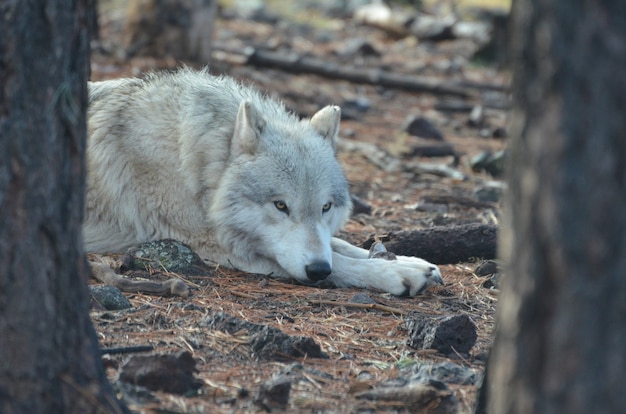(Part 1) Before We Get Started: The Ethical Compass

Legality:
- First things first, make sure you're legally allowed to hunt wolves in your area. Check with your local wildlife authorities. They'll lay out the rules, the permits you need, and how to hunt sustainably. It's all about respecting the law and the land.
- If you're not a seasoned hunter, consider joining a hunting group or working with a guide who can teach you the proper techniques and help you stay safe.
Ethics:
- Think about the impact of wolf hunting on the environment and other species. Wolves are apex predators, and their presence plays a vital role in maintaining ecological balance. There are strong opinions on both sides of this issue. It's important to approach it thoughtfully and consider the long-term consequences of your actions.
- Personally, I believe in a "use it or lose it" approach. If you're going to hunt, make the most of the animal, respect its life, and minimize waste. That's how we connect with the land and appreciate the food we eat.
(Part 2) The First Step: Preparing the Meat

Field Dressing:
- Field dressing is the first step. This is where you remove the internal organs to keep the meat fresh. It's a bit of a messy job, but it's essential. There are plenty of online resources and videos that can guide you through the process.
- Remember, cleanliness is key. You want to make sure the meat stays free from contamination and stays safe for consumption.
Skinning and Butchering:
- Skinning a wolf can be challenging, especially if you're a beginner. It takes some practice and sharp tools. There are different techniques, so find one that suits you. If you're unsure, it's best to seek help from an experienced hunter or butcher.
- Once you've got the skin off, you can start butchering the carcass. This means dividing the wolf into manageable pieces. This is where a sharp knife, a sturdy cutting board, and a good butchering guide come in handy.
- You can cut the meat into steaks, roasts, ground meat, or smaller pieces, depending on how you plan to cook it.
(Part 3) Tasting the Wild: Wolf Meat’s Unique Flavor Profile

Gamey Goodness:
- Think of it as a cross between venison and beef, with a more pronounced, robust flavor. Some people say it's similar to lamb or mutton.
- Don't be afraid to experiment with different cooking methods and seasonings to bring out the best in wolf meat. You can try strong spices, like cumin, chili powder, or coriander, or use herbs like rosemary, thyme, and sage to add depth and complexity.
(Part 4) Cooking Wolf Meat: Unveiling the Flavors
Now for the fun part: cooking! There are so many ways to prepare wolf meat. It's versatile and adaptable, so you can get creative in the kitchen.The Classic Roast:
- A roast is a classic way to cook wild game. Season the meat liberally with salt, pepper, and your favorite herbs. I like to use rosemary, thyme, and garlic, but you can use a blend of herbs for a more complex flavor.
- You can roast it in the oven or over an open fire. The open fire adds a smoky flavor that's hard to resist.
- For a more tender roast, try marinating the wolf meat overnight in a mixture of olive oil, vinegar, and spices.
Sautéed Success:
- For a quick and easy meal, sauté wolf meat in a pan with onions, garlic, and your favorite vegetables. Serve it over rice, mashed potatoes, or even noodles.
- For a lighter dish, try sautéing the wolf with lemon juice, capers, and fresh parsley. This creates a bright and flavorful dish that's perfect for a summer evening.
The Stir-Fry Sensation:
- Wolf meat also shines in stir-fries. Cut it into small pieces and stir-fry it with your favorite vegetables and sauces.
- I like to use a combination of soy sauce, ginger, and garlic for my stir-fries, but get creative and experiment with different flavors, like teriyaki or peanut sauce.
(Part 5) Wolf Meat Recipes: A culinary adventure
Here are a couple of my favorite recipes to get you started. These are just starting points, so don't be afraid to experiment with different ingredients and techniques.Recipe 1: wolf meat stew 2 pounds wolf meat, cut into 1-inch cubes 1 large onion, chopped 2 carrots, chopped 2 celery stalks, chopped 4 cloves garlic, minced 2 bay leaves 1 teaspoon dried thyme 1/2 teaspoon black pepper 1 cup red wine 2 cups beef broth 1 tablespoon flour 1 tablespoon olive oil
Instructions:
- In a large dutch oven or pot, heat the olive oil over medium heat. Brown the wolf meat on all sides. Remove the meat from the pot and set aside.
- Add the onions, carrots, and celery to the pot and cook until softened, about 5 minutes. Stir in the garlic, bay leaves, thyme, and black pepper.
- Pour in the red wine and beef broth. Bring to a boil, then reduce heat and simmer for 10 minutes.
- Whisk the flour into a small bowl with a few tablespoons of cold water. Add the flour mixture to the pot and stir until the stew thickens slightly.
- Return the wolf meat to the pot. Reduce heat to low, cover, and simmer for 2-3 hours, or until the meat is very tender.
- Serve the stew hot with crusty bread or mashed potatoes.
Recipe 2: wolf meat chili 1 pound wolf meat, cut into 1/2-inch cubes 1 onion, chopped 1 green bell pepper, chopped 2 cloves garlic, minced 1 tablespoon chili powder 1 teaspoon cumin 1/2 teaspoon oregano 1/4 teaspoon cayenne pepper (optional) 1 (28-ounce) can crushed tomatoes 1 (15-ounce) can kidney beans, drained and rinsed 1 cup beef broth 1/4 cup chopped cilantro (optional) Salt and pepper to taste
Instructions:
- In a large pot or Dutch oven, brown the wolf meat over medium heat. Remove the meat from the pot and set aside.
- Add the onion, green pepper, and garlic to the pot and cook until softened, about 5 minutes.
- Stir in the chili powder, cumin, oregano, and cayenne pepper (if using). Cook for 1 minute, stirring constantly.
- Add the crushed tomatoes, kidney beans, beef broth, and the browned wolf meat back to the pot. Bring to a boil, then reduce heat and simmer for 30 minutes, or until the chili has thickened.
- Stir in the chopped cilantro (if using), and season with salt and pepper to taste.
- Serve the chili hot with your favorite toppings, such as shredded cheese, sour cream, or chopped onions.
(Part 6) The History of Wolf Meat: A culinary journey Through Time
Cooking wild game connects us to our ancestors, who relied on hunting and foraging for survival. It's a reminder of how humans have interacted with nature throughout history.Ancient Traditions:
- People have hunted and eaten wolves for millennia. It's not just about survival, it's about a long-standing tradition, a connection to the land and its resources.
- Wolf meat has been a staple food in many cultures across the globe. It's a part of their history, their identity, and their relationship with the natural world.
(Part 7) The Conservation Connection: Respecting the Cycle of Life
There's more to this than just a delicious meal. Hunting and cooking wild game can play a crucial role in conservation efforts.Sustainable Practices:
- When done responsibly, hunting helps regulate wildlife populations and maintain a healthy ecosystem. It's a way of ensuring that species have a chance to thrive and that the environment remains balanced.
- By utilizing the entire animal, including the meat, we're minimizing waste and showing respect for the animal and the land.
(Part 8) Beyond the Kitchen: Sharing the Experience
It's about more than just cooking. It's about building connections, sharing stories, and passing on traditions.Sharing the Harvest:
- Cooking and eating wolf meat is a great way to bring people together. Share your stories about the hunt, the preparation, and the meal itself.
- It's about sharing a sense of adventure, a connection to nature, and a deep appreciation for the food we eat. It's about building traditions and forging bonds that last.
(Part 9) Wolf Meat: A Culinary Journey
Wolf meat. It's a wild card. It's a taste of the untamed. It's a culinary adventure. It's a reminder of our connection to the natural world.The Unexpected Delight:
- Embrace the challenge, the flavor, and the history behind this wild game. Don't be afraid to try new things. You might just discover a new favorite meal.
- Who knows? Maybe you'll become the next wolf meat aficionado.
(Part 10) FAQs
1. Is wolf meat safe to eat?
As with any wild game, it's crucial to handle and cook wolf meat properly to ensure it's safe for consumption. Make sure you follow proper hygiene practices, like washing your hands and surfaces thoroughly and cooking the meat to the right temperature. A food thermometer is a great way to ensure the meat is cooked through and safe to eat.
2. What does wolf meat taste like?
Wolf meat has a distinct gamey flavor, often described as similar to venison or beef, but with a stronger, more intense taste. It can also have a slightly sweet or even slightly metallic flavor. The taste can vary depending on the animal's diet and age.
3. Is it legal to hunt wolves?
The legality of hunting wolves varies depending on your location and the specific species. Always check with your local wildlife authorities for regulations and permits.
4. What are some good wolf meat recipes?
Wolf meat is quite versatile and can be used in a variety of dishes. Some popular recipes include wolf meat stew, wolf meat chili, wolf meat burgers, and wolf meat sausages. You can also try braising, roasting, or grilling wolf meat.
5. Why should I eat wolf meat?
Eating wolf meat can be a sustainable way to utilize wild game resources. It also connects you to ancient traditions and promotes a deeper appreciation for nature. It can be a unique and rewarding culinary experience, allowing you to connect with the land and its bounty.
Everyone is watching

How to Cook Frozen Lobster Tails Perfectly: A Step-by-Step Guide
RecipesLobster. Just the word conjures up images of lavish meals, special occasions, and a taste of luxury. But let's...

Pork Fillet Cooking Time: How Long to Cook It Perfectly
RecipesPork fillet, or tenderloin as it's sometimes called, is a real favourite in our house. It's so versatile, and...

Pigs in a Blanket Cooking Time: How Long to Bake for Perfect Results
RecipesAh, pigs in a blanket. Just the name conjures up images of those delightful little parcels of crispy pastry en...

The Ultimate Guide to Cooking Delicious Frankfurters
RecipesLet's face it, we all love a good frankfurter. It's a classic, simple, and always satisfying. But let's be rea...

Wolf Meat Recipes: A Guide to Cooking Wild Game
RecipesLet's be honest, you don't see wolf meat at your local butcher shop every day. It's a bit of a wild card, but ...
